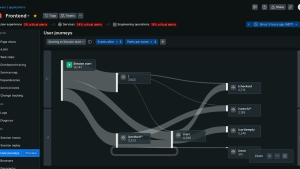Our two peak periods are the European summer and Black Friday sales. Before any peak time at Kurt Geiger, we do certain rituals to check our tech. And there’s a lot to check. We run five websites, retail stores across the UK and Ireland, in addition to a B2B business with select partners. To prepare for our big days, we review our alert thresholds, run through different toggles on our platform to make sure they can be turned on and off, and look at coverage gaps to see if there’s any system that has slipped the net. If there are any critical issues, we need to be alerted to them immediately.
Improving our Core Web Vitals score
Google’s Core Web Vitals is one of the most important ways we judge how performant our site is. Having a low Core Web Vitals score can potentially impact your rank in Google searches. If you're top of Google search, you generally get better traffic coming to your site. If you're scoring low it’s because you're failing on fundamental website performance, such as caching, load time, and large images. Luckily, Google tells you what you're failing at, so you can make those improvements and target your monitoring to show you that you are improving as well.
Gauging our baseline
E-commerce makes up a large part of our business revenue at 30%-40%. Paid search makes up somewhere of the 25% of users that make it to our site, followed closely by organic search at some 23%. To be successful, we need to build a great digital experience for our customers. That means a fast and engaging website, and more importantly, a frustration-free way to check out and buy.
Previously, a marketing agency would tell us what to improve but they didn’t know how to measure Core Web Vitals performance. Our marketing and engineering teams were very siloed. We had a generic graph on Google Analytics that showed us if performance was going up or down but it wasn’t very granular.
We decided to start a program to improve our Core Web Vitals score. From the technical side, we used custom instrumentation to ingest data from Magento to New Relic. New Relic helped surface the visibility of our score. We noticed quickly that our score was really low, around the 45-50 mark. We needed to aim for a score of around 80-85 to be successful.
Uniting data into a Core Web Vitals dashboard
We created a Core Web Vitals dashboard in New Relic to align our engineers, management, and digital teams and show this is what's going on with our site and the improvements we needed to make. Now, we can see through the day if there’s been a spike in performance. We can see what auto resolves and what Core Web Vitals metrics are affected. Our engineering teams are aligned to this dashboard as a single source of truth on our performance. We’ve built alerts with New Relic Query Language (NRQL) to fire from this data in case we fall below industry standards.
New Relic also gave us some good examples of funnels. We used this to understand user flow across our site, from checkout to home page to product listings, and to identify any potential weak points of drop-off areas. Our checkout was one area we wanted to understand better. We pushed custom data from every customer session into our dashboard and these became key metrics for us. This data from Next.js gave us absolute values on each metric, including these critical elements of our checkout, that we could then attach alerts to.
Chet discusses how Kurt Geiger improved their Core Web Vitals score by creating a dashboard with New Relic.
Moving SEO in-house
Another big change this dashboard brought us was the ability to bring SEO in-house with our own engineers. We were able to improve caching, server side rendering, image compression—fashion traditionally loves a glossy image and lots of them and videos—among other things. Now it’s much easier to generate SEO reports that help us optimize keywords. Our SEO people can use Google and New Relic to see the impact of technical changes on Core Web V.
Promoting DevOps and end-to-end ownership
Our Core Web Vitals project has brought engineering, management, and our digital teams, which are not traditionally technical, together. There's good inter-team communication happening now around performance. We’re much less reactive now. We have data in New Relic to prove that the customer experience is good or bad. That's been a real game-changer. It's made our DevOps teams self-sufficient. They look at these dashboards now to understand what’s happening in real time, without having to rely on asking test or performance engineers. That gift of autonomy has been the best bit. Our teams can build and monitor their own alerts, running everything from coding to production.
Six months after we started this project, we saw our Core Web Vitals score jump from 45-50 to 85-90. We're exceeding our expectations. Now, I don’t get customer complaints that the site is slow. We’re sure that 99% of our customers are having a good experience.
Read our guide on monitoring Core Web Vitals and install a Core Web Vitals dashboard via Quickstart to see how performant your site is.
The views expressed on this blog are those of the author and do not necessarily reflect the views of New Relic. Any solutions offered by the author are environment-specific and not part of the commercial solutions or support offered by New Relic. Please join us exclusively at the Explorers Hub (discuss.newrelic.com) for questions and support related to this blog post. This blog may contain links to content on third-party sites. By providing such links, New Relic does not adopt, guarantee, approve or endorse the information, views or products available on such sites.



